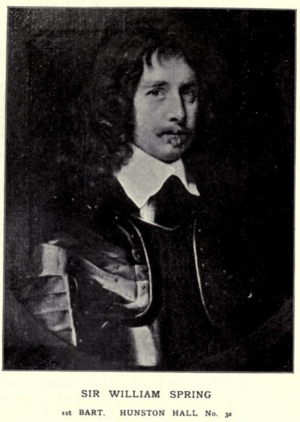Sir William Spring, 1st Baronet facts for kids
Sir William Spring, 1st Baronet (born in 1613, died in 1654) was an important English politician. He was a Parliamentarian, meaning he supported the Parliament against the King during the English Civil War. He belonged to the Spring family from Pakenham, a town in Suffolk, England.
Contents
Early Life and Family
William was the son of another important person, Sir William Spring (who died in 1637), and his mother was Elizabeth Smith. Just like his father, William went to Emmanuel College, Cambridge for his education. He was the only son who survived, so he inherited all the family's land and homes, including Pakenham Hall and Cockfield Hall. For many years, he lived at Newe House in Pakenham, which he bought from Sir Robert Bright.
A Life in Politics
King Charles I made William a knight. In 1641, he served as the High Sheriff of Suffolk. This was a very important job, like being the chief law enforcement officer for the county.
In August 1642, there were some troubles called the Stour Valley anti-popery riots. These were about religious disagreements. Parliament asked Sir William to search Hengrave Hall, the home of his cousin, Lady Penelope Darcy. People thought weapons for a Catholic uprising might be hidden there.
Even though William was known to be a strong Parliamentarian and disagreed with the King's plans, King Charles I still made him a baronet on August 11, 1642. A baronet is a special title, like a knight, but it can be passed down through the family.
Role in the English Civil War
During the English Civil War, Sir William traveled around the eastern parts of England. He helped to find and recruit soldiers for the Parliament's army. He also worked to make sure Parliament stayed in control of East Anglia.
While there is no record of Sir William fighting in battles, he was a key member of the Bury St. Edmunds Committee. This committee was part of the Eastern Association, a group of eastern counties that worked together to support Parliament. This group helped recruit men for Oliver Cromwell's famous cavalry, known as the Ironsides.
Sir William often wrote letters to Oliver Cromwell. Cromwell even wrote to Spring about important ideas like the "Good Old Cause," which was about fighting for Parliament's beliefs.
In 1643, Spring had a disagreement with Cromwell. Spring didn't want to accept a group of Ironsides soldiers led by Captain Raphe Margery. Spring thought Margery, who was not from a wealthy or noble family, was not important enough to lead soldiers. But Cromwell disagreed. He told Spring that he didn't care about a soldier's social class. What mattered was that they knew what they were fighting for and believed in Parliament's cause. In September 1643, Cromwell famously wrote to Spring: I had rather have a plain russet-coated captain that knows what he fights for, and loves what he knows, than that which you call a gentleman and is nothing else. This meant Cromwell preferred a skilled and dedicated soldier over someone who was just born into a high social class.
Sir William was a close friend of Sir Nathaniel Barnardiston, who was a strong supporter of the Puritan religion. In 1645, Spring was chosen to represent Bury St Edmunds in the Long Parliament. He served there from 1646 to 1648. Later, in 1654, Spring also served in the First Protectorate Parliament for Suffolk. He passed away at the end of that year and was buried on December 19. His oldest son, William, took over his title and lands.
Sir William's Family
William married Elizabeth L'Estrange. She was the daughter of Lady Alice and Sir Hamon L'Estrange. William and Elizabeth had six children together:
- Sir William Spring, 2nd Baronet (1642–1684): He married Mary, the daughter of Dudley North, 4th Baron North, but they had no children. He then married Sarah, the daughter of Sir Robert Cordell, 1st Baronet. With Sarah, he had three children.
- Thomas Spring: He never married and died in 1677. He was a Fellow at Gonville and Caius College, Cambridge.
- John Spring: He traveled to the New World (America) and settled in Watertown, Massachusetts. He became an important person and politician there.
- Elizabeth Spring: She never married.
- Catherine Spring: She married Captain Laurence first, and then later married John Palgrave.
- Dorothy Spring (1648–1714/15): She married Sir Christopher Calthorpe in 1664.


